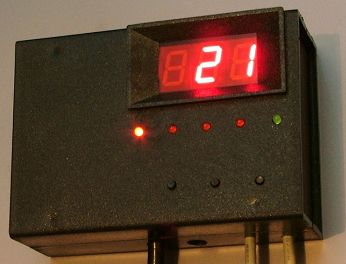
D I F F E R E N T I A L T H E R M O S T A T v1
 DTE1 is packed with numerous functions specific to the target application - controlling of home solar water heating systems. More precisely, DTE1 should be refered to as a "differential thermostat" as it has an output TRIAC by which it controls operation of water heating system in accordance to the difference between the temperature in the solar water heating panels and the hot water tank - if it is above the desired threshold set by the user, it powers on the water circulating pump in order to enable heat energy transfer from solar panels to the tank. Should the temperature difference fall below the threshold, the pump is turned off stopping unwanted heat transfer from in this case hotter water tank to colder solar panels.
DTE1 is packed with numerous functions specific to the target application - controlling of home solar water heating systems. More precisely, DTE1 should be refered to as a "differential thermostat" as it has an output TRIAC by which it controls operation of water heating system in accordance to the difference between the temperature in the solar water heating panels and the hot water tank - if it is above the desired threshold set by the user, it powers on the water circulating pump in order to enable heat energy transfer from solar panels to the tank. Should the temperature difference fall below the threshold, the pump is turned off stopping unwanted heat transfer from in this case hotter water tank to colder solar panels.
 The diagram on the right shows a typical home solar water heating system installation and the role of a differential thermometer within it. As can be observed, there are two temperature sensors. One of them should be placed onto a solar panel outlet tube while the other one should be placed onto the hot water storing tank outlet tube. This way, thanks to the water flow, the thermometer is able to measure water temperatures inside two major system blocks and based on those measurements it can decide whether water should be circulated by the circulating pump with the aim of transferring thermal energy from solar panel into the tank. It is important to note that a differential thermometer needs to be flexible enough in its operation as solar water heating systems differ significantly among themselves. This is caused by the differences in piping lenght and thermal insulation, solar panels azumuth and geographical position etc. Therefore, each differential thermometer representative must provide means for adequate adjustments in order to enable optimal exploitation of the given solar system into which it was built in.
The diagram on the right shows a typical home solar water heating system installation and the role of a differential thermometer within it. As can be observed, there are two temperature sensors. One of them should be placed onto a solar panel outlet tube while the other one should be placed onto the hot water storing tank outlet tube. This way, thanks to the water flow, the thermometer is able to measure water temperatures inside two major system blocks and based on those measurements it can decide whether water should be circulated by the circulating pump with the aim of transferring thermal energy from solar panel into the tank. It is important to note that a differential thermometer needs to be flexible enough in its operation as solar water heating systems differ significantly among themselves. This is caused by the differences in piping lenght and thermal insulation, solar panels azumuth and geographical position etc. Therefore, each differential thermometer representative must provide means for adequate adjustments in order to enable optimal exploitation of the given solar system into which it was built in.